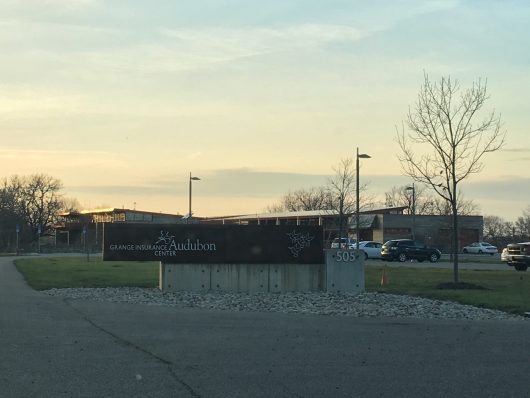
Tim Daniels spoke at The Grange Insurance Audubon Center about his experiences as a wildlife photographer. Credit: Olivia Balcerzak | Lantern reporter
While being charged at by a mother black bear, some run away but not Tim Daniel.
“She snorted and stood up, ran about 10 yards, and then stood there and looked at me,” said Tim Daniel, photographer for the Wild Ohio Magazine. “My immediate reaction is ‘give me my camera, I want to go over here and take a picture’ and then my secondary reaction, after the adrenalin had died down was ‘what the heck were you thinking?’ ”
This was one of many risky photos Daniel said he has taken in his 25 years of experience working as a photographer for the ODNR.
On Monday, the OSU Chapter of the Fish and Wildlife Society invited Daniel to speak on those experiences, sharing his photos and stories about wildlife in Ohio. The event was held at the W as a dual effort for both the chapter and the center to promote environmental education.
Robert Reed, chapter secretary and a third-year in natural resources management, said the chapter is a part of the national organization for the Wildlife Society, which connects wildlife professionals with students.
“We try to do professional development events at the student chapter level, connecting students with hiring managers and wildlife professionals, whether it be ODNR or The Nature Conservancy or other natural resource and wildlife professional careers,” Reed said.
Reed said hosting speakers who work with wildlife, such as Daniel, help spread awareness about wildlife preservation.
“With increased human population and decreased wildlife population, I think that, as a society, it’s our job to help manage for wildlife habitat and population,” Reed said.
Daniel said, as a photographer, he has personally seen the decline in wildlife population.
“The places that I used to photograph, private property 10, 15 years ago are no longer there, that habitat has been destroyed,” Daniel said. “That is an emotional issue for me. When I see that, it takes me a while to rebound, I get this feeling like, wow, I must not be doing enough.”
To combat those feelings, Daniel said he does his best to educate people about wildlife preservation whether it is talking to family members or through the Wildlife Division social media pages.
“I love Instagram because it’s a day in the life of what I do,” Daniel. “I try to tell the whole story.”
In doing so, Daniel said he supplements wildlife photos and video with captions that both educate people about what is being photographed and promotes the division.
“We need people on our side to have a total understanding of what we do, so that’s the promotional part,” Daniel said. “And the educational part is just telling them something I don’t think they knew, and the entertaining part is just something flashy or pretty.”
However, Daniel told the audience that while some of the photos might be pretty, the process of getting those photos, including waiting all night for an animal that might or might not show up, is sometimes not so delightful.
“It’s one of those things where you think wildlife photography is really cool and glamorous and it’s not,” Daniel said. “Some days you’re really just nasty, it’s boring and sweaty…. but sometimes you get the shot, that’s the payoff.”
Reed said he got to experience that payoff firsthand two summers ago, when he worked as Daniel’s intern. While Reed might have not stood face-to-face with a black bear, he said he did get to experience some of the risk involved with wildlife photography, including flipping hundreds of pieces of tin roof over, looking for rattlesnakes to photograph.
“Tim used his GoPro and he got super close to the snake and it actually released venom on the camera,” Reed said. “In wildlife management, there’s always a risk of encountering wild animals that are harmful but I think that, through wildlife photography, we can capture some interesting and unique elements that the public won’t necessarily see.”
However, Daniel said that the animals might not be the only cause of harm when photographing risky images.
“A lot of photographers … let the adrenalin take over and it’s not only scary, it’s possibly harmful for the wildlife because you’ll approach something with adrenalin that may put the wildlife in danger,” Daniel said.
Daniel said this danger includes scaring a mother away from its eggs, opening the babies up to predation. Despite the danger, Daniel said the photographs are worth it.
“It’s a drive that’s hard to explain,” Daniel said. “You want to get the shot so you can share it with people, make them understand, get a better appreciation. So it’s worth it, definitely.”
The Wildlife Division can be found on Instagram under the username “your_wild_ohio.” The OSU Chapter of the Fish and Wildlife Society meets biweekly on Tuesdays at 5:30 p.m. in Kottman Hall, room 245.


